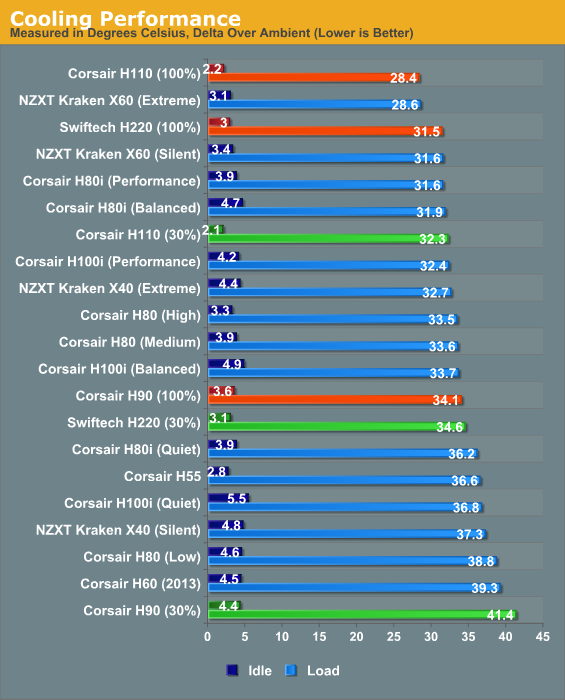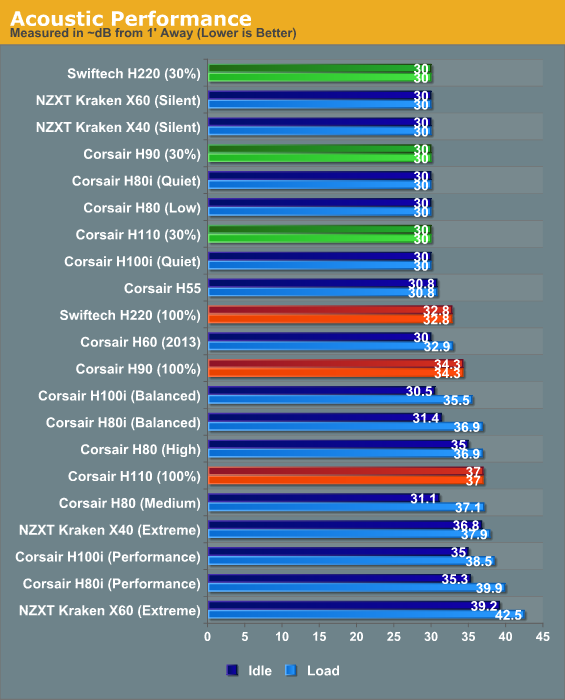Closing the Loop II: New Liquid Coolers from Corsair and Swiftech
by Dustin Sklavos on February 1, 2013 12:01 AM EST- Posted in
- Cases/Cooling/PSUs
- Corsair
- radiator
- Swiftech
Performance Results
I mentioned in the introduction that the new Corsair radiators are operating off of the same OEM hardware as NZXT's resident 140mm-based radiators. What I didn't mention was that Corsair doesn't have any software control for the fans or even any allowances made towards connecting and controlling the fans at all beyond the conventional motherboard headers. Corsair needs to hope the fans used on their H90 and H110 are enough to differentiate them from NZXT's Kraken series.
Swiftech, meanwhile, also uses PWM control, but includes a breakout block with the H220 to connect as many as seven different fans to a single PWM channel. It's worth noting, too, that though the Swiftech H220 is a 240mm radiator (like the Corsair H100i), the building materials and pump are almost completely different. The pump uses Swiftech's own secret sauce, while the radiator uses brass and copper instead of the garden variety aluminum the other radiators use. On top of this, they're using their own fans. Suffice to say, it's going to be interesting to see if the H220 can prove the extra effort and higher quality components are worthwhile.

Whether it's Corsair, NZXT, or good old-fashioned Asetek, the results don't lie: the 280mm radiator is just plain more efficient than any smaller block. Swiftech's H220 puts in a reasonably strong showing, though interestingly it has trouble overtaking the Corsair H80i at higher speeds. There's a very good reason for that, though, and you'll see it in a second.
Meanwhile, Asetek's single 140mm radiator basically continues to be a bust. It's by no means a terrible product, but the H90 and Kraken X40 are both pretty underwhelming. A thicker 120mm radiator with two fans continues to be a comparable if not superior choice.

If the Swiftech H220's performance is a little underwhelming, this is why. The H220 itself is definitely a strong radiator, but Swiftech clearly tuned their fans for acoustics instead of performance. At 30% fan speed only the X60 and H110 can offer both better thermal performance and fan speed, but at 100% fan speed, the louder, more aggressive fans are just able to push more cool air through their respective radiators.
What must be kept in mind is that while the H220 isn't necessarily blowing up the charts, the noise levels and thermal performance need to be connected and placed in context. The H220 is able to deliver competitive performance at lower noise levels than the competing radiators, and really only has to worry about the Corsair H110 and Kraken X60 beating it. Both of those are much harder to fit into most cases, too, a problem the Swiftech H220 doesn't have.










53 Comments
View All Comments
landerf - Friday, February 1, 2013 - link
Does the H110 come with a Y connector for the fans?Dustin Sklavos - Friday, February 1, 2013 - link
Nnnnnnope.landerf - Friday, February 1, 2013 - link
So for most the cost is actually +5 after a quick trip to ebay. Not that I mind. My last Corsair Y connector disintegrated.krutou - Friday, February 1, 2013 - link
In a future review, I'd like to see entry level (similarly priced) custom loops included.Primarily, I'd like to see the XSPC Raystorm 750 RS240 (~$150) reviewed. XSPC is known for their excellent performance and I'd like to see it compared to an upgradable AIO like the Swiftech H220.
aguilpa1 - Friday, February 1, 2013 - link
I have been looking intently at the Kraken 60 because of it's performance, and ability to hold 4 fans in push/pull as well as what appears to be longer tubing than a standard closed loop. I have a full tower Lian Li the P80 I believe and it has an old school design of the power supply above the motherboard tray. I am not sure I could work those really short tube lengths that are the norm for these systems, assuming everyone has clear space right above the motherboard.I wish reviewers would test these units in a case and not just the glossy brochure model. I have seen them even worse set up on a test bench where installation is not even considered just raw performance numbers with no real world basis for installation and use.
Kepe - Friday, February 1, 2013 - link
Dustin tested these inside a case?Dustin Sklavos - Saturday, February 2, 2013 - link
Uh...I tested these inside a case, yes. All of this information is readily available on the conspicuously named page "Testing Methodology."yohanus - Friday, February 1, 2013 - link
Swiftech has been a great company. I have built multiple water cooling setups using their products and have been nothing but pleased when dealing with them on the internet or, more importantly, on the phone.I must admit that these closed loop systems look really nice compared to taking a Buick A/C condenser and heater core, a pump, some cpu coolers and building a single cooling system that runs two computers. The benefit of a closed loop system is that it just works while a homebrew system allows you the satisfaction of tinkering.
Sabresiberian - Saturday, February 2, 2013 - link
Yah the Swiftech system here looks like it might be the choice for someone looking to get into watercooling of more than just the CPU at a relatively low cost. (that being said - GPU waterblocks are expensive, heh).I'm wondering though if starting off with a better pump, fans, and radiator might be worth the extra cost, especially if you plan on cooling 3 GTX 680s or the like.
ggathagan - Saturday, February 2, 2013 - link
It comes down to whether or not it's more expensive to buy the H220 and modify the loop with additional water blocks and radiators, or to build from scratch.From what all I've read on this particular system, the pump is easily the match to Swiftech's premier pump, the MCP35X.
That is the basis for their other waterblock/pump combo, the Apogee II.
If you already know that you want to cool a triple GPU system, the H220's components aside from the waterblock/pump might be wasted if you have a full tower case that can accommodate larger radiators and fans.
Further, starting from scratch gives you the flexibility to pick-and-choose each individual component.
In that scenario, you might find that there are other brands that provide you with a better waterblock, fan or radiator than the ones offered by Swiftech.